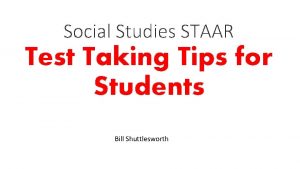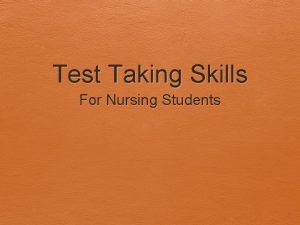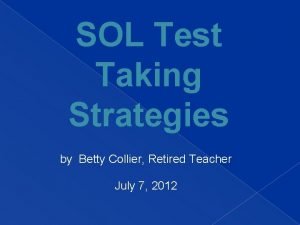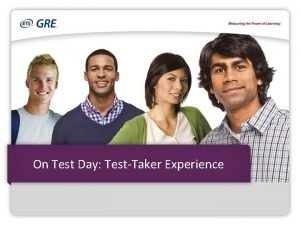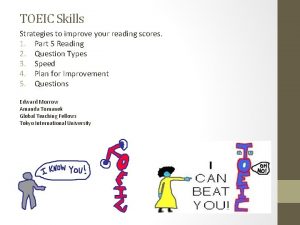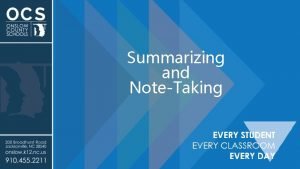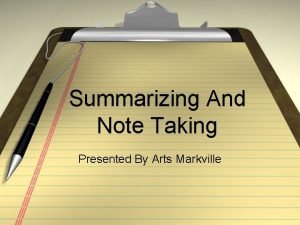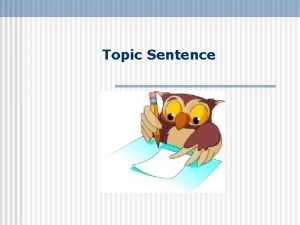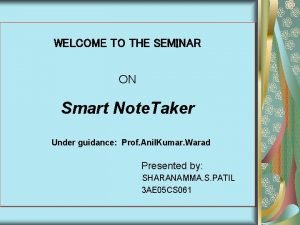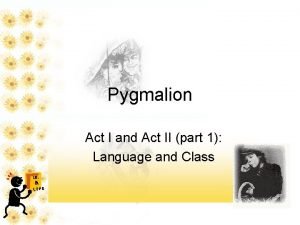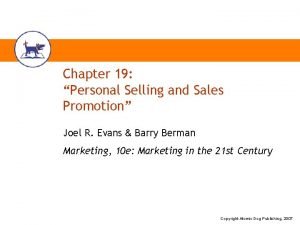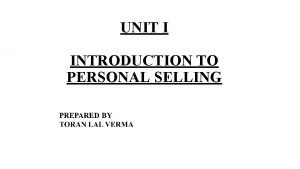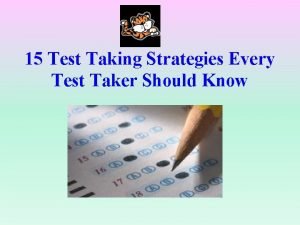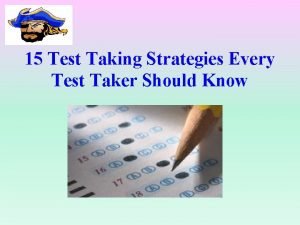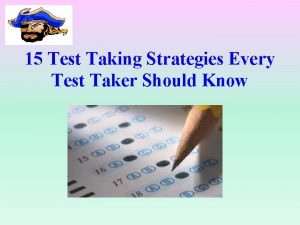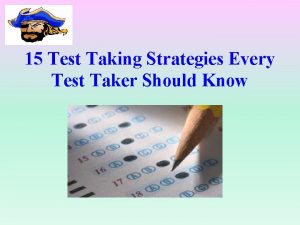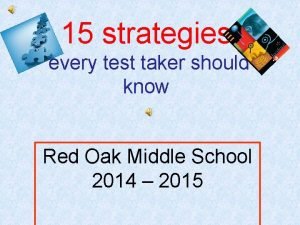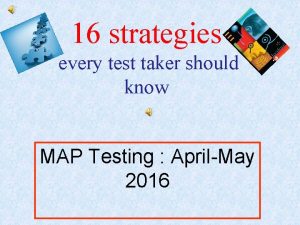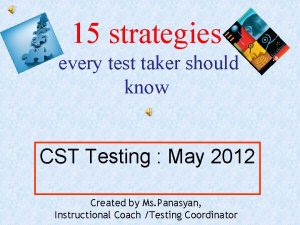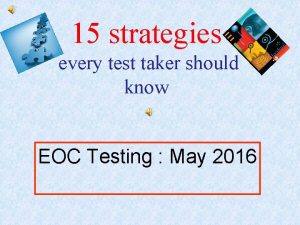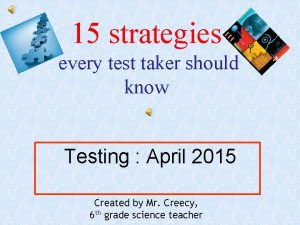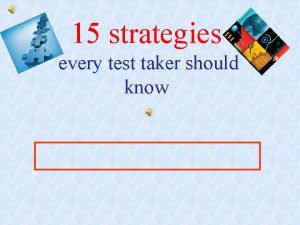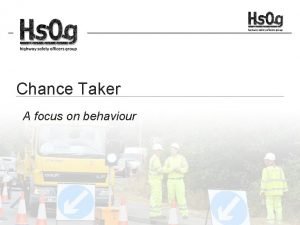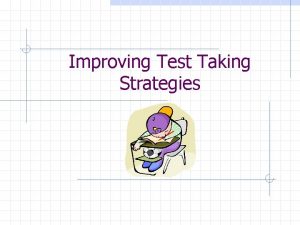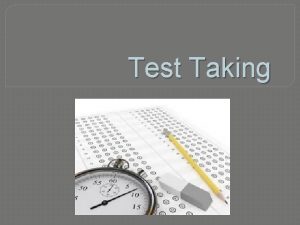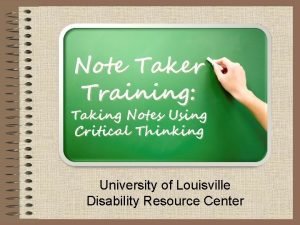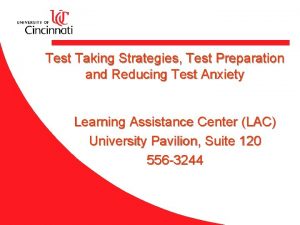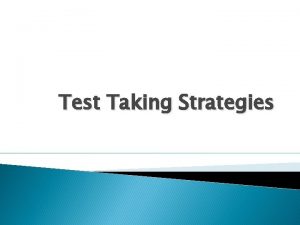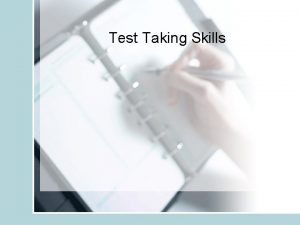15 Test Taking Strategies Every Test Taker Should

























- Slides: 25

15 Test Taking Strategies Every Test Taker Should Know TAA Lesson 6 April 25, 2018


• Get plenty of rest the night before each testing day You need 8 -10 hours of sleep, so go to bed by 10 pm. • Avoid the morning rush. Set out clothes the night before. Get to school a few minutes earlier than you usually do. • Eat a good nutritious breakfast the morning of each testing day (Milk w/cereal, eggs, fruits; no Hot Cheetos and candy. )

Always listen to the LISTEN directions given by teacher. • Read the directions written on the test. READ • Read the question and ALL answer ASK choices before marking anything.

2. It is important 1. Don’t spend too much time on any one question. 5. Answer the easiest questions first, but be sure to go back to those questions you skipped. to answer every question even if you are not sure of the answer. 4. Save time at the end to review your test and make sure you haven't left out any answers. 3. Use all your time! There are no extra points for finishing early.

Eliminate obviously wrong answer choices If you can’t figure out which answer is correct, try to eliminate (get rid of) the answers that you know are wrong. Eliminate choices that are partly correct Eliminate items that are correct but don’t answer the question

A random guess gives you a 25% chance of getting the right answer. An educated guess gives you chance of answering correctly up to 75%. Educated guessing means using everything you know to attempt to answer the question.

ANSWERS WITH THE FOLLOWING WORDS ARE USUALLY WRONG/FALSE. ALL ALWAYS MUST NONE NEVERY ENTIRELY BEST WORST ONLY EVERYONE

SOMETIMES GENERALLY USUALLY FREQUENTLY PROBABLY MOST FEW MANY OFTEN SELDOM ANSWERS WITH THE FOLLOWING WORDS ARE USUALLY CORRECT/TRUE

WHEN THE ANSWER IS NOT CLEAR, LOOK FOR CLUES ( CONTEXT, TENSE, WORD TYPE, GRAMMAR) IN THE QUESTION AND THE ANSWER CHOICES The context of a word includes all the words and sentences that surround it and the situation in which the word is used.

Clue words in test questions: Who? Person What? Thing Where? Place When? Time Why? Reason Which? Choice How? A way something is done How many ? Number

The effect of negatives is to make the sentence the opposite of what it would be without the negative. Negatives: Not None No one Hardly Scarcely Prefixes such as Un- Non- Dis- In- Simplify the question by getting rid of double negatives. Simplify this statement: Most people are not unafraid of snakes. Most people are afraid of snakes.

In Math, ESTIMATING is an approximate answer obtained by rounding the numbers BEFORE you add, subtract, multiply, or divide. Always ask yourself: “Is the answer reasonable? ” What is 325+917+ 796? A. 56 B. 2038 C. 1038 D. 10, 564

Other Math Tips • Use Scratch Paper. • Double Check To Make Sure You've copied the problem correctly. • Line Up Place Values (thousands, hundreds, tens, ones) Neatly To Avoid Careless Mistakes. • Pace Yourself. MOVE ON AND GO BACK!

1. Read all the titles, labels, and other given information 2. Check the units of measurement 3. Look for a pattern, trend, or comparison in the graph or table

1. Read the title of the map 2. Check the map key( legend) 3. Look at the map scale (if you need to find a distance) 4. Re-read the question again

• Answers about where and when the story takes place are found at the beginning. • Answers about a problem of the story are usually found in the middle. • Answers about how the problem was resolved are usually found at the end.

When Reading a Passage Remember To: READ THE QUESTIONS FIRST to determine what you are looking for as you read the selection.

What’s the Big Idea? • Events and characters that make up the story • The purpose of the story • The point the author is trying to make Tip: Look for the Big idea in the first two paragraphs of the story!

Don’t misbubble If you reach a hard question and can’t make your educated guess, an easier one is just around the corner. Write a light “? ” next to the question you are skipping and move on to the next question.

How Do You Prevent Misbubbling? At the end of the test, go back ? to the questions with next to them and see if you can try to answer it. Please be sure to answer every question.

When You Are Done … ü Fill in bubbles fully, write neatly, and erase stray marks. ü If you finish early, check to make sure you have answered all questions. ü Once you have finished, please remain quiet as others will still be working on the test.

I am scared of the test monster!!!! Remember the strategies! They will help you to feel confident. • Think positively about doing your best! • Take a deep breath to relax. • Answer EVERY question. • Make intelligent educated guesses. • Think about one item at a time. • DO YOUR BEST!

Reduce Your Test Anxiety With Practice • Confidence comes from practice and becoming familiar with the format. • USATestprep and i. Ready will give you the practice you need to help you stay calm and do your best.

By Using The Test Taking Strategies You Have Learned Today, and With Practice, You Can Improve Your Test Taking Skills and Test Scores. YOU CAN DO THIS! Sources: “Preparing Middle School Students for High Stakes Tests, ” Tara Musslewhite, Atascocita Middle School, Humble, Texas “ 15 Strategies Every Test Taker Should Have, ” Vista Middle School, Van Nuys, CA
 Social studies staar test
Social studies staar test Eog strategies
Eog strategies Test taking strategies for middle school
Test taking strategies for middle school Test taking strategies for nursing students
Test taking strategies for nursing students Math multiple choice test taking strategies
Math multiple choice test taking strategies Sol test taking strategies
Sol test taking strategies Test taker experience
Test taker experience Toeic reading time management
Toeic reading time management Summarizing and note taking strategies
Summarizing and note taking strategies Summarizing and note taking strategies
Summarizing and note taking strategies Every nation and every country
Every nation and every country Microsoft's mission statement
Microsoft's mission statement Every knee shall bow every tongue confess
Every knee shall bow every tongue confess Every rotarian every year
Every rotarian every year Every nation and every country
Every nation and every country Every picture has a story and every story has a moment
Every picture has a story and every story has a moment Every child every day
Every child every day What should every efl teacher know
What should every efl teacher know Chapter 6 personal care skills
Chapter 6 personal care skills Example of topic sentence in a paragraph
Example of topic sentence in a paragraph Mobile note taker
Mobile note taker Pygmalion act 1 theme
Pygmalion act 1 theme Price taker
Price taker Buyer seller dyad
Buyer seller dyad Functions of personal selling
Functions of personal selling Cervical sample taker database norfolk
Cervical sample taker database norfolk
